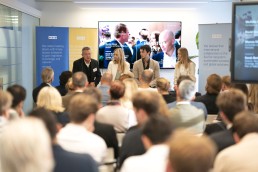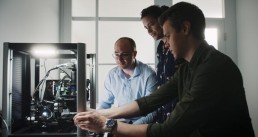Opening doors for Swedish tech: Lessons from Access UK
What does it take to turn international ambition into actual market traction? For ten Swedish tech companies, Access UK offered a sharp, three-day answer.
Organised by Kista Science City in collaboration with the Swedish Chamber of Commerce and the British Embassy in Stockholm, the programme brought a selected group of deep tech, climate tech, and connectivity scaleups to London during London Tech Week. The goal: to accelerate UK market entry through high-level meetings, direct insights, and on-the-ground experience.
The result was a tightly focused week of tailored customer meetings, speed networking, panel sessions, and expert briefings — all based in London, but with insights and connections reaching across the UK’s broader innovation landscape.
“The programme delivered what many don’t: real access, honest conversations, and a clear view of both the opportunities and the hurdles ahead,” said James Campion, CEO of TeraSi.
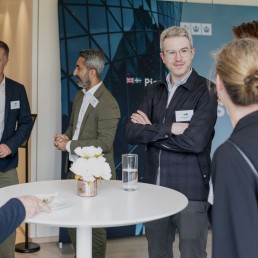
Image Credit: Swedish Chamber of Commerce for the UK
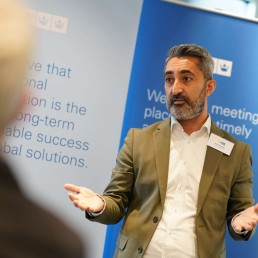
Image Credit: Swedish Chamber of Commerce for the UK
From insight to traction
By the end of the week, several companies had already secured follow-up meetings or opened discussions about potential partnerships. For others, the biggest shift was strategic: clearer positioning, sharper communication, and a stronger understanding of how to move forward.
“There’s a shift you start to notice,” said Arash Sangari, programme manager at Kista Science City. “Participants are still energised, but already thinking ahead — how to bring the learnings home, how to make the UK a real priority. That kind of momentum, from insight to action, is exactly what we’re aiming for.”
Much of that momentum came from the people in the room: investors, journalists, ecosystem leaders, and fellow entrepreneurs. The Access UK programme combined intimate roundtables with media and PR experts (including Sifted), with structured investor matchmaking and exposure at major industry gatherings like the Chamber’s Tech Forum.
And while London was the hub, the UK opportunity is broader. “Cambridge, Manchester, Bristol – the regional ecosystems are alive with talent, capital, and unmet demand,” Campion reflected. “The UK is open for business, and the hangups of Brexit feel like a thing of the past.”
Learning the landscape — and standing out in it
For many participants, the week also brought clarity around what makes the UK market different. Sales cycles, proof points, and partner expectations vary — and local context often matters more than companies anticipate.
“The hardest part isn’t just getting meetings — it’s understanding how business actually works here,” said Sangari. “What kind of traction do you need to convince a buyer? How are relationships built? What are the red flags you didn’t know you were giving off?”
According to Alfred Lindberg of Univrses, part of the value came from going together with other Swedish tech companies. “It gives you weight. Even as a small company, you’re not showing up alone — and that opens doors. Plus, you share more than you think with the other companies. Different fields, same challenges.”
That trust also extends to the Swedish brand. From sustainability to engineering quality, Swedish companies often arrive with a reputation that works in their favour — a legacy built by decades of successful Nordic expansion into the UK. But translating that into deals takes structure, preparation, and credible support.
“It’s easy to underestimate how competitive these markets are,” said Lindberg. “Initiatives like this are a smart way to help Swedish companies hold their ground — especially in strategic fields like AI and infrastructure, where we want to stay globally relevant.”
What’s next?
For Kista Science City and its partners, the work doesn’t stop when the flights land. The team will continue to support this year’s participants as they take next steps — from navigating ongoing UK conversations to preparing for entry into other international markets.
“Part of our role is to make sure companies are prepared before they go,” said Sangari. “But just as important is what happens after — helping companies stay focused, keep up the momentum, and make use of the networks they’ve built.”
Looking ahead, Access UK is one piece of a broader effort to give Swedish tech companies the right conditions to grow internationally — faster, and more strategically. That includes continued collaboration with the British and Swedish embassies, the Chamber, and ecosystem partners like London & Partners.
Global competition isn’t slowing down, and neither should Swedish scaleups.

Image Credit: Swedish Chamber of Commerce for the UK
Get involved
Access UK is a market acceleration programme run by Kista Science City in collaboration with the Swedish Chamber of Commerce for the UK and the British Embassy in Stockholm.
This autumn, Access Germany will bring ten Swedish growth companies to Munchen, with new programmes launching in the US and Canada in 2026.
To learn more about upcoming programmes or connect withparticipating companies, reach out to Arash Sangari at arash.sangari@kista.com.
Kista companies invest early in future tech talent
Sweden’s new STEM strategy has set ambitious goals for education and industry collaboration. In Kista, companies are moving from policy to practice — meeting students sooner, building relationships, and redefining what it means to secure tomorrow’s tech talent.

In February 2025, the Swedish government launched a new STEM strategy to strengthen education and encourage closer collaboration between schools and industry — from preschool through to PhD. The goal is to raise performance, broaden participation, and help more young people find a path into science, technology, engineering, and maths.
This national focus is echoed in Kista, where more companies are choosing to act early instead of waiting until students are ready to enter the workforce. They’re hosting workshops, running hands-on activities, and listening to young people’s perspectives. This isn’t about charity; it’s a business-critical move.
IBM and eCiceron are two companies putting this new approach into action. We asked them what’s driving this shift — and what they’ve learned so far.
From policy to practice
At IBM, that work includes national initiatives like the Cybersecurity Academy — developed together with MSB and Unga Forskare to build digital safety skills and spark interest in tech. In 2024 alone, the programme reached over 260,000 children and young people through workshops, events, and training. The aim is to reach even more this year.
eCiceron, a Kista-based tech firm specialising in digital security, has stepped up its involvement with local talent. The company recently participated in Tech Talent Connect — part of Systemvetardagen — where more than 500 university students in cybersecurity, AI, and computer science were matched with prospective employers. Events like these help eCiceron both raise its profile among young people and hear firsthand what tomorrow’s tech professionals care about.
The value of acting early
For both IBM and eCiceron, early engagement with young people isn’t just about visibility — it’s a way to stay relevant and adaptable in a rapidly changing tech landscape.
“We want to ensure a diverse and future-ready workforce,” says Evelina Pärnerud, CSR Manager at IBM. “By reaching young people early, we can spark an interest in technology—not just for those who will work directly in the industry, but for everyone. Tech literacy is becoming essential for all sectors of society.”
Marc Rantanen, CEO of eCiceron, puts it this way: “The biggest benefit is not just access to new skills, but the cultural and strategic agility this new generation contributes. By integrating young talent early, we future-proof our company and keep ourselves on the edge of innovation and culture.”
For both companies, the focus is shifting away from simply filling roles. The goal is to build a talent pool that’s adaptable, curious, and aligned with how technology — and society — are evolving.

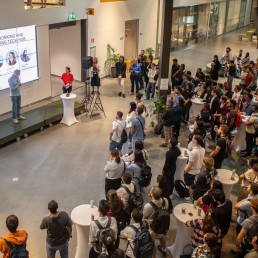
Two-way learning
Opening up to students has become a way for companies to challenge their own thinking and adapt to new perspectives. Both IBM and eCiceron say that working with students has sparked fresh ideas inside their own teams.
“Young people are incredibly smart, and they often push us to think in new ways,” says Evelina Pärnerud. At IBM, student interactions have sparked internal conversations around how problems are framed, what assumptions are held, and how openness to new perspectives can unlock innovation.
eCiceron has seen similar effects. “We’ve had cases where a student, with the right mindset, has accelerated into the business faster than a more senior professional,” Rantanen explains. “That challenged our assumptions about the typical learning curve. Potential and attitude can outweigh experience — especially in tech.”
These experiences aren’t one-offs. For companies, working with students is becoming part of a bigger shift. One where recruitment and development are less about static processes, and more about building ongoing relationships and learning together.
The risk of waiting
Some companies already treat student engagement as a core strategy. Others are still deciding when — or if — to get started. But as competition for talent intensifies, the argument for early action keeps getting stronger.
That risk isn’t just about missing the best candidates. “It’s about staying relevant, competitive, and prepared for the challenges ahead,” says Evelina Pärnerud. Students form impressions early, and by the time they enter the job market, many already know which companies they associate with purpose, opportunity, or innovation. Getting on their radar early should be a top priority.
Rantanen at eCiceron warns that companies who wait too long to build relationships with students risk losing relevance — both technically and culturally: “Without strong pipelines from academia and youth communities, companies may face a talent cliff where the next generation simply doesn’t consider them relevant or attractive.
Moreover, without the diversity of thought that young professionals bring, companies may fall into stagnant thinking and miss out on disruptive ideas. In our industry, that can mean falling behind in security innovation, failing to adopt new standards, or not seeing emerging customer needs early enough.”
The next generation will decide which companies feel relevant, innovative, and worth joining. Those building relationships today will likely be the ones to attract talent tomorrow.
National priorities, local action
Sweden’s new STEM strategy sets the direction: stronger tech education, earlier engagement, and closer collaboration between schools and industry. But policies only matter when they’re put into practice, and that happens locally.
In Kista, these ambitions are already becoming reality. Companies are joining school-led initiatives, opening their doors to students, and finding new ways to support the education ecosystem. Some are building long-term partnerships, while others start small — with a single event, workshop, or class visit.
The common denominator is a shift in mindset. In practice, this means the gap between education and industry is narrowing — one conversation at a time.
“We’re seeing more companies in Kista get involved in talent initiatives — especially in areas like cybersecurity, semiconductors, and AI,” says Mikaela Färnqvist, Talent and Community Manager at Kista Science City. “Our role is to coordinate these efforts and make it easier for companies to get involved—whether it’s through major initiatives or smaller actions. By staying committed and actually working together, we can achieve results that matter and last.”
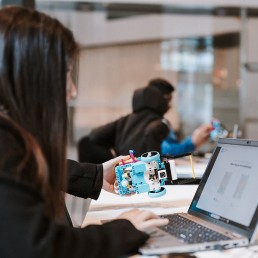
For those who haven’t begun yet, the path forward is clear. Reach out to mikaela.farnqvist@kista.com to get involved!
From code to clinic: New lab tech from Qamcom and Mabtech
What happens when two companies from entirely different domains team up, and stay teamed up? In the case of Mabtech and Qamcom, nearly a decade of collaboration has led to EYRA: a new research platform designed to streamline high-precision lab work in immunology.
Mabtech, a biotech firm specialising in immunoassays and instruments for research, brought the scientific insight. Qamcom, an engineering company based in Kista, contributed deep technical expertise. Together, they’ve built a system that makes it faster and easier to detect dozens of immune-related analytes — and is poised to being used across various research fields such as vaccines, inflammation, and infectious diseases.
Making lab work easier
EYRA, a purpose-built confocal microscope, supports a method called multiplex immunoassays, which allows researchers to analyse many immune markers in a single run. The platform delivers high-sensitivity with minimal manual work — no calibration, fluid handling, or clean-up required — and is designed to support long-term studies without compromising consistency.
“What really makes an advanced instrument like EYRA different is the simplicity,” says Christian Smedman, CTO at Mabtech. “It’s so user-friendly that even someone with no lab experience could use it — and that’s not something you could say about competing systems.”
Its intuitive setup also supports automation, a key factor for labs scaling up to clinical trials and larger research programmes.
Combined expertise, shared goals
The development of EYRA wasn’t a one-off assignment. It was the outcome of a long-term R&D collaboration that started in 2016 and kept evolving through two full-scale product development phases, feature upgrades, and continued joint refinement.
Mabtech guided the scientific direction and core functionality. Qamcom provided the complete design and development of the laser-based instrument.
“We don’t have the technical know-how to put together a sophisticated instrument like EYRA,” says Smedman. “But we helped shape it by working together with Qamcom’s engineers toward better performance and a more intuitive user experience. From the very beginning, we’ve talked about our cooperation with Qamcom, since it gives us credibility in an area where we don’t have expertise.”
Ann Louise Johansson, General Manager at Qamcom, notes that the working structure played a big role in building alignment and trust over time.
“From day one, we’ve met face-to-face every four weeks to set directions, handle issues, and decide on next steps,” she says. “Even when we weren’t in active development phases, we kept that rhythm. That consistency helped us stay aligned and ensure focus on the right things.”
As Johansson sees it, strong expertise and trust — across disciplines and over time — are what made the project succeed.
“It’s at the intersection of disciplines where the most powerful breakthroughs happen. No single team could have done this alone. But together, we’ve built something that can make an impact and genuinely improve outcomes in bioscience and public health.”

